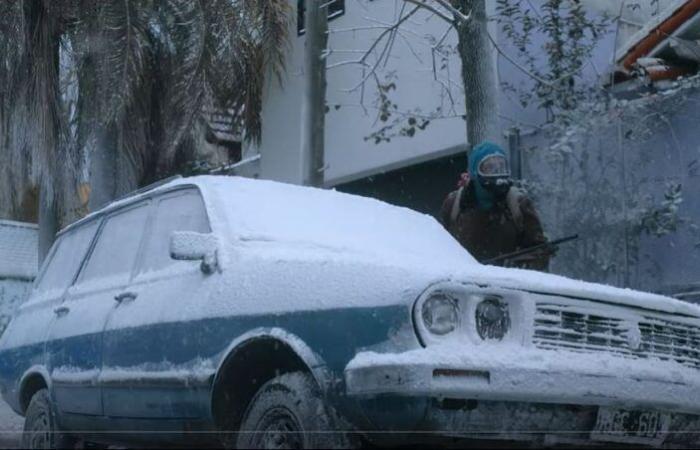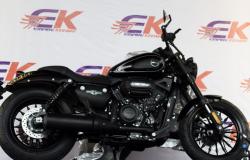Total tendency since its premiere, the Argentine series “El Eternalauta” had an outstanding performance worldwide, becoming the Third more seen in the worldbehind the last season of You and animated production Asterix & Obelix: The Big Fightaccording to the specialized site FlixPatrol.
Based on the classic cartoon created by Héctor Germán Oesterheld and Francisco Solano LópezArgentine production was launched worldwide last Wednesday, April 30. The address is in charge of Bruno Stagnaro and the cast is made up of Ricardo DarínCarla PetersonAriel StatelyCésar TrunkMarcelo SubiottoClaudio Martínez Bel and Andrea Stoneamong others.
With an impressive level of production and special effects, history tells an apocalyptic scenario in Buenos Aires after an alien invasion on Earth, which uses a toxic snowstorm to annihilate most of the population. Invasion resistance is led by Juan Salvo (Darín), who will be in charge of the survival of the group fighting for freedom.
In the first minutes of the series, the storm generates that electrical circuits and electronic equipment are affected by high radiation from the rupture of Van Allen’s belts (which causes the toxic snowstorm). This interrupts communications, satellites, GPS and other electronic devices.
As a consequence, They do not even work modern cars. However, in the course of history, The protagonists realize that “the old works”so they can use some artifacts such as an old radio, a toadiscos and some vehicles that are already their years, becoming great protagonists of the plot.
At one point in the series, a Ford F100 rescues Juan Salvo and his companions from being attacked by extraterrestrial cascarudos. Since its arrival in 1959 and with national production from 1961 at the Pacheco plant, This flat became one of the most emblematic trucks in the country. Designed for hard work, it was quickly adopted by rural and commercial users for their mechanical reliability and load capacity.
during successive decades, he incorporated improvements in motorization, design and comfort. Over time he added options with whole wheel traction, consolidating its reputation as a synonym for resistance.
Produced locally by industries Kaiser Argentina (IKA) from 1957, The stagnant was one of the first sports utility vehicles made in the countrycombining mechanical strength with functionality for both rural and daily use in city. It is one of the first models to appear in the series.
Equipped with four -cylinder motorizations, offered versions with simple or integral traction, which extended its versatility. His design of straight lines and robust metal structure granted him a simple but efficient aesthetic, which contributed to his popularity. Production ended in 1979after more than two decades of permanence in the market, leaving a deep brand in the Argentine automotive history.
Released in 1973 by Ika-Renault, the rural version of the well-known Renault 12 He extended the offer of one of the most successful models of his time. Known as “Break”, the variant was consolidated as an ideal option for middle -class families, standing out for their amplitude, functionality and low maintenance cost.
He shared mechanics with the sedan, including the 1.4 -liter engine, front -wheel drive and independent suspension. Its production was extended until 1994, consolidating its place as one of the durability and economy referents of its generation.
Presented in 1974, Ford Taunus was the first European style model manufactured by the brand in Argentina. Produced in the Pacheco plant until 1984, the model offered sedan and coupé versions, the latter incorporated the following year and highly valued by speed and design enthusiasts.
-It arrived with a range of engines that included options of 1.6, 2.0 and 2.3 liters. After a decade of success, it was replaced by the Ford Sierra.
The Mehari was one of the most unique models that circulated along the Argentine routes in the 70s. Manufactured locally between 1971 and 1980, its rupturist design and resistant plastic body made it a versatile and original vehicle.
Derived from the Citroën 2CV, it used a bicylindrical engine combined with front -wheel drive and an effective suspension in irregular roads. Its light structure, removable roof and basic seats made it ideal for both recreational activities and rural tasks. Throughout “El Eternalauta” his practicality is more than clear.
A model that could not be missing in the tape. Between 1966 and 1982, The Torino became one of the greatest exponents of Argentine automotive development. Conceived from the Rambler American, it combined European refinement with mechanical robustness adapted to local conditions.
Manufactured at the Santa Isabel plant in Córdoba, sedan and coupé versions were offered and almost 100,000 units were produced that are part of the model’s legacy in the country.
Manufactured between the 70s and mid-90s, the Mercedes-Benz 1114 was a fundamental medium truck for national transport. With six -cylinder and 5.7 -liter diesel engine, it stood out for its durability, economy of use and versatility.
This model could be configured as a van, chassis-chassis, dump or collective, both urban and interurban. Its mechanical resistance and maintenance ease made it a key tool to move load and passengers throughout the country. In the series we see its adaptation as motorhomeallowing the protagonists to sleep in the vehicle during the trip.
While in the series their passengers do not stand out for their good actions, the Peugeot 404 enjoys a participation in the foreground. The model began its production in Argentina in 1962, assembled by the Argentine Industrials Manufacturers of Automobiles (IAFA) until 1964. Production was resumed in 1965 by the Franco Argentina of Automotive Corporation (Safrar), a society composed of Peugeot and Citroën. Throughout its career in the country, more than 160,000 units were manufactured in various versions: sedan, rural, pickup and sports variants.
He stood out for his robustness, reliability and versatility, characteristics that made him a popular vehicle in both urban and rural environments. The production of 404 in Argentina ended in 1980 after the absorption of safating by the European Society of Vehicles for Latin America (Sevel), a joint venture Between Fiat y Peugeot.






